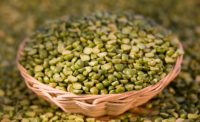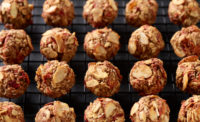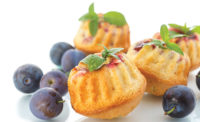Grains are fundamental ingredients in snacks and baked goods, providing function, flavor, texture and nutrition. Grains are classified as either whole grains or refined grains. Whole grains contain the entire kernel—the endosperm, bran and germ—whereas refined grains have been processed to remove the bran and the germ, which also removes the dietary fiber, iron and some of the B vitamins. Many refined grains are subsequently enriched with certain B vitamins and iron to compensate for the loss of nutrients during processing.
The nutrients that grains provide are important for overall health and wellness. For example, B vitamins play a key role in metabolism, and dietary fiber, from whole grains, may help reduce blood cholesterol levels and lower the risk of heart disease, obesity and type 2 diabetes.
The 2015-2020 U.S. Dietary Guidelines recommend including grains as part of an overall healthy eating pattern. Based on a 2,000-calorie diet, the recommended amount of grain is 6 ounce equivalents per day, and at least half of the grains consumed should be whole grains. In looking at grain consumption, while total grain levels are close to the target, consumers are not meeting recommended levels for whole grains. However, NHANES data shows some directional improvements in increasing whole grain consumption, while also reducing the levels of refined grains. In addition, according to data from the International Food Information Council’s 2017 Food and Health Survey, 84 percent of consumers recognize whole grains as healthy, and 65 percent of consumers state they are eating more foods with whole grain.
Growing with corn
Cargill, Minneapolis, recently introduced a new finely ground corn bran to its product portfolio, making it possible to incorporate insoluble corn fiber into a broader array of snack and bakery products. The product is allergen-free, gluten-free and has a clean label, appearing on labels simply as “corn bran.” The ingredient is derived through a chemical-free, mechanical process to fractionize and separate the kernels into their three components: germ, starch and fiber/bran.
“Although corn bran is an insoluble fiber, by creating a much-finer particle, it’s more suspendable, making it more useful in applications that would traditionally need the properties of a soluble fiber,” says Keith Smith, regional technical service lead, Cargill. “The new finely ground corn can be used to make cakes and brownies that qualify for being labeled as a ‘good source’ of fiber. The resulting high-fiber cakes and brownies have a smooth mouthfeel with none of the adverse tooth-pack that is typically associated with traditional corn bran ingredients that are not finely ground.”
Another example of a potential food application using the new finely ground corn bran is a high-fiber, direct-expansion extruded snack, such as a cheese curl, which again could qualify as a “good source” of fiber. “The use of Cargill’s new finely ground corn bran significantly reduces the negative impact of fiber addition on the degree of expansion at the exit of the extruder, while at the same time improving the mouthfeel of the snack food,” says Smith.
Cargill has also demonstrated the new finely ground corn bran as a bulking agent in reduced-sugar baked goods without sacrificing taste.
Bunge North America, Chesterfield, MO, recently acquired Minsa’s U.S. mills, expanding its portfolio of corn masa flours to include yellow and white, as well as vibrant colors, and non-GMO and organic options. Bunge’s portfolio now includes a single source for tortilla ingredients, including high-quality masa flours, shortenings and oils.
Earlier this year, the company began offering certified transitional dry milled corn ingredients to help meet the growing demand for organic products. “Farmers are interested in serving the growing organic market, but many don’t participate because the process to achieve certification takes three years and can be cost-prohibitive,” says Mark Stavro, senior director of marketing, Bunge North America. “The certified transitional program allows farmers to sell corn at a premium during this transition period. We at Bunge connect these farmers with snack manufacturers and bakers who are interested in Certified Transitional products as a way of building a more scalable and reliable future supply of organic products.”
Healthy Food Ingredients, Fargo, ND, recently added a flaked version to their line of Suntava Purple Corn products. “Purple-colored foods, such as Suntava Purple Corn, are excellent sources of anthocyanins and other polyphenols,” states Tara Froemming, marketing coordinator. The new flaked product can be used in a number of applications, including chips, clusters, extruded and puffed snacks, and granola and pressed bars. The Suntava Purple Corn flakes are whole-grain, minimally processed with natural color and have a clean label. They are available as organic or non-GMO.
Ancient options
According to NPD Group’s SupplyTrack, case shipments of ancient grains to foodservice—often a leading indicator of emerging ingredient trends—increased by 18.5 percent in 2017.
“We’re seeing more usage of grains like quinoa, amaranth and sorghum as nutritious additions to chips and snack bars,” says Don Trouba, senior director, go-to-market, The Annex by Ardent Mills, Denver. “Bakers and consumers are also interested in older, heritage ingredients because they are considered to be cleaner, simpler and have interesting stories and origins behind them. These grains provide nutty, earthy flavors that blend well with sweet and savory ingredients, such as nuts, dried fruits and natural sugar/syrups. Texture is also important in the eating experience of snacks. In crisped, cracked, flaked and IQF forms, grains can offer different textures and mouthfeel to snacking formulations.”
Crisps, suited for use in snacks and bar applications, are available in Great Plains quinoa, sorghum, sorghum flakes, amaranth, brown rice and Black Jack barley flakes.
“Barley’s roots go back thousands of years, while its applicability in bars and snacks makes it a modern powerhouse,” says Trouba. “BlackJack Barley flakes add nice texture for a dense, filling snack bar that provides sustained energy, and the beta glucan content shows promise in prebiotic applications.”
Sorghum is experiencing significant growth. Dustin Finkel, CEO and founder, Ancient inGRAINed Snack Co., Erie, CO cites SPINS data noting sorghum sales grew by 123 percent this past year. Sorghum, including sprouted and cracked types, provides great eye appeal and flavor, and can be used across a broad range of snack and bakery products, including pretzels, muffins, breads, cookies, crackers, chips, flatbreads, bagels and more.
James Curry Ph.D., president, International Food Systems LLC, New Braunfels, TX, notes sorghum’s many benefits:
- Sorghum and cracked sorghum acts as a flavor enhancers thanks to enzymes that convert starch to maltose, imparting improved flavor to bakery products
- Sorghum increases digestibility, which improves nutrition
- Sorghum is gluten-free
- Sorghum is rich in health-promoting phytochemcials
Sorghum is packed full of protein, fiber, omega 3s, potassium, vitamins and minerals, explains Finkel. The company has introduced Ka-Pop! Chips, made with 100 percent ancient grains. “Made with sorghum, Ka-Pop! Chips are positioned to positively impact the fast-growing snack category with its clean and transparent ingredient panel,” he says. “All we do is pop sorghum, add oil and seasonings and provide a good-for-you snack without empty calories.” Ka-Pop! Chips are available in four varieties: Olive Oil & Sea Salt, Rosemary & Garlic, Dairy-Free Cheddar and Sea Salt & Vinegar.
The grain provides a strong sustainability story, as well. “Ancient grains are remarkably regenerative to the land they grow on, which is vital to maintaining nutrient-rich soil,” says Finkel. “From a sustainability standpoint, sorghum is incredible for our farmlands and soil biodiversity. It uses a fraction of the water that other modern grains use for growth, and they can cycle nutrients and accelerate carbon sequestration into the soil. So, not only is it good for our bodies, it’s also good for the earth.”
Agspring, Leawood, KS, the parent company of Firebird Artisan Mills, has been working with the ancient grain teff, incorporating it into new products over the past year. “Teff is a rare complete protein that can enable snack makers and bakers to make protein claims with an ancient grain without using any type of additive,” says Bradford Warner, vice president of marketing, customer engagement and sustainability. “Teff would also allow the snack or baked good to remain gluten-free and vegetarian, and potentially even vegan depending on the total formulation.” Teff provides a mild flavor and is a very flexible ingredient that can be used across multiple applications, including muffins, cakes, pancakes, waffles and breads.
New forms of fiber
Fiber is gaining more interest with consumers as they become more aware of the role fiber plays in health and wellness.
Grain Millers Inc., Eugene, OR, has added a new grain-based ingredient, oat fiber BCS30-SL-B, which is longer and softer than the company’s existing line of oat fibers. “This is one of the few concentrated intrinsic and intact fibers, and thus was approved even prior to the recent FDA guidance on dietary fiber,” says Rajen Mehta, PhD., senior director specialty ingredients. “No part of the original raw material is thrown away. No chemicals are used, and only enough water is added to compensate for evaporation losses during grinding. Because of this, it preserves phytonutrients and components with anti-inflammatory properties. This new ingredient allows higher fortification levels with the addition of a single fiber and can be used in extruded snacks, bakery products and also pasta snacks.”
Typically there is a limitation on the amount of insoluble fiber you can add to extruded products. However, since the new oat fiber is soft, long and strong, it allows for greater expansion in extruded snack products. In bakery applications, use levels of soluble fiber can be limited based on the potential to cause intestinal discomfort, explains Mehta. “This new insoluble oat fiber does not have the same limits.”
Gluten-free strategies
Glanbia Nutritionals, Chicago, offers a line of OatPure oats that are 100 percent Irish oats and are completely gluten-free. The product is available in the following formats: shredded oats, jumbo oat flakes, steel cut oats or quick cook oats. The company has developed a new supply chain standard to ensure gluten-free oats, called OatSecure, which is an NSF 14-step supply-chain process.
“We manage the entire supply chain in the gluten-free oats, from when it comes from the farm to when it is delivered to our customers,” says Chuck Steenwyk, product strategic manager, emerging platforms, Glanbia Nutritionals. “We take the extra steps when assuring gluten-free contamination. We partner with neighboring farms so there are not gluten crops grown anywhere within a half mile surrounding our harvest area. This is just one of the many examples of the extensive rigor around our supply chain.”
The company also offers clean-label functional ingredients that also deliver nutritional benefits, such as a milled flax seed. “We have a functional milled flax seed that works well for gum and emulsifier replacement,” says Steenwyk. “The benefit is that an ingredient like xanthan gum would be replaced with milled flax seeds. Flax seeds and other grains can be added in a fine mill or in a larger particle size to add visual appeal in products such as muffins.”
Another example is BevGrad Chia White, a super-fine cold milled chia seed, which is an exciting new ingredient, because of its ability to build viscosity in syrup systems for bar applications, notes Steenwyk. “It helps reduce sugar in the formula, as well as remove binders and emulsifiers, helping product developers clean up their labels.”
With the gluten-free trend continuing, we are starting to see more grain-free foods. “Interest for so-called grain-free ingredients has helped usher in ingredients as diverse as root vegetables, pulses and even coffee flours,” says Warner. The company has worked in applying garbanzo beans and green lentils to new food products. “For garbanzo beans, we see applications in all-purpose flour, baking mixes, crackers, pretzels and chips. Green lentils have been used successfully in cracker and chips.”
Additional enhancements
Brolite Products, Bartlett, IL, launched its Natural Spelt Mold Inhibitor this past year. “This product is made with organic ingredients and acts as an all-natural flavor, and a mold inhibitor,” says Jeff Nelson, western vice president of sales. “By using the latest culture technology, the Natural Spelt Mold Inhibitor will give additional shelf life by lowering the pH. It can be added to a product at 1 to 2 percent per 100 pounds of flour. It’s a clean-label-friendly product, as well.” Using this ingredient provides longer shelf life while still maintaining the taste and texture of the finished product.
Whole grains can sometimes impart woody, earthy or bitter off-notes that are considered undesirable by consumers. FlavorHealth, North Brunswick, NJ, has developed new taste modulators that can help address these off-notes. “We have specifically looked at the receptors that the off-notes of whole grains trigger and found flavors that decrease the response,” says Kushal Shah, marketing specialist. “The result is an improvement in the taste profile of the product that we often find allows the positive attributes to be accentuated. Products are often reported as sweeter or more flavorful, because the distracting flavors—such as whole grain off-notes—are minimized.”
FlavorHealth’s suite of solutions gives manufacturers the opportunity to increase the healthiness profile of their products while still maintaining the great taste to which their consumers are accustomed.
People today are much more cognizant of the foods they eat and are looking to achieve better overall wellness by improving their eating habits. They are seeking out clean-label, plant-based products, often with higher protein and fiber content. In addition, snack manufacturers are developing products using new bases, such as whole, heirloom and ancient grains. Collectively, these trends plants the seeds for the continued growth of grains.








